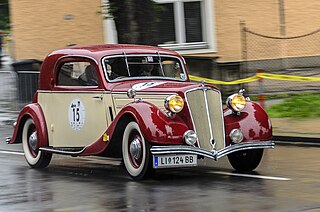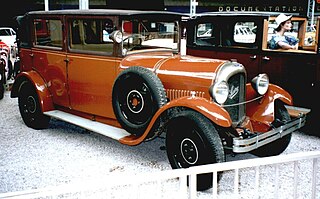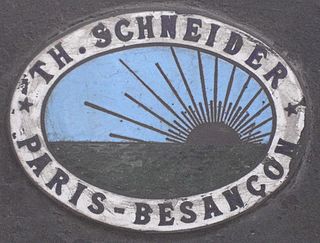
Brasier was a French automobile manufacturer, based in the Paris conurbation, and active between 1905 and 1930. The firm began as Richard-Brasier in 1902, and became known as Chaigneau-Brasier in 1926.

Unic was a French manufacturer founded in 1905, and active as an automobile producer until July 1938. After this the company continued to produce commercial vehicles, retaining its independence for a further fourteen years before being purchased in 1952 by Henri Pigozzi, who was keen to develop Unic as a commercial vehicle arm of the then flourishing Simca business.
Berliet was a French manufacturer of automobiles, buses, trucks and military vehicles among other vehicles based in Vénissieux, outside of Lyon, France. Founded in 1899, and apart from a five-year period from 1944 to 1949 when it was put into 'administration sequestre' it was in private ownership until 1967 when it then became part of Citroën, and subsequently acquired by Renault in 1974 and merged with Saviem into a new Renault Trucks company in 1978. The Berliet marque was phased out by 1980.
Buchet was a French motorcycle and automobile manufacturer between 1899 and 1930.

Zédel was a Swiss automobile manufacturer established in 1901 by Ernest Zürcher and Herman Lüthi. The name of the company was created by combining the first letters of the founders' names, "Z" and "L".

Charron was a French automobile manufacturer, based in the Paris conurbation, and active between 1906 and 1930.

Corre La Licorne was a French car maker founded 1901 in Levallois-Perret, at the north-western edge of central Paris, by Jean-Marie Corre. Cars were produced until 1947.

Société des Automobiles Bellanger Frères was a French automobile manufacturer between 1912 and 1925. The cars were the brainchild of Robert Bellinger (1884-1966), who had previously sold Delaunay-Belleville vehicles.

The Bignan was a French automobile manufactured between 1918 and 1931 on the north side of central Paris, in Courbevoie. The business was created, and till the mid 1920s-headed up, by Jacques Bignan.

The Delage D6 is a six-cylinder luxury car produced by the manufacturer between 1930 and 1940 and again, after the war, between 1946 and 1953. For much of this time it was the company’s principal or, from 1946, only model.

Ryjan was a make of French automobile produced by the Grillet company between 1920 and 1926. The factory was established in what was then a small town, a short distance to the west of Paris, called Chatou. In 1925 production was relocated to Nanterre in the west of the country.

The Nervastella is a large automobile constructed by Renault between 1930 and 1937. It was used as a state car and pictures of the president of the French Republic sitting in a Nervastella can therefore be seen in newsreels from the mid-1930s.

The Salmson S4 is a mid-size executive-level car introduced as the Salmson S4 C by Société des Moteurs Salmson in Autumn 1932. It was the manufacturer's principal and often sole model for the next twenty years.

Automobiles J. Suère was a French manufacturer of automobiles between 1909 and 1931.

Benjamin was a French manufacturer of cyclecars between 1921 and 1927 and based on the north-west edge of Paris. 1927 was a year of changes which included a name change, and between 1927 and 1929 the company operated under a new name, Benova.

Th. Schneider was a French automobile manufacturer.

Vinot-Deguingand was a French automobile producer.
Société des Nouveaux Ateliers A. Deguingand was a short-lived French automobile manufacturer.

The Vivaquatre is a car produced by Renault between 1932 and 1939. Its large 4-cylinder engine placed it initially in the 10CV car tax class, though a larger engine later made it a contender in the 11CV class.

The Renault Vivasport was a 6-cylinder engined executive automobile introduced by Renault in September 1933 and produced till April 1935. A larger engined version was produced between December 1934 and February 1938. As with many Renaults during the 1930s, type changes as well as small often cosmetic facelifts and upgrades appeared frequently.



















